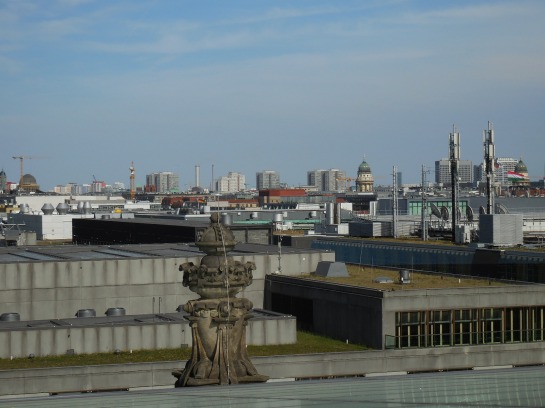
The Brandenburg Gate
On my way to the Reichstag, I stopped to admire the Brandenburg Gate. I noticed the Dunkin Donuts and Starbucks on the Unter der Linden near the monument in what had once been East Berlin. I remembered passing through the Brandenburg Gate on the way to East Berlin in July of 1991. The moment I walked through the gate, I felt as if I had entered a different world – a grey, stagnant, suffocating and gloomy one. However, I remember West Berlin as vibrant and bustling during that visit.

I took a few moments to reflect on the historical moments associated with the neoclassical gate in front of me. It was built in the 18th century for Prussian King Frederick William II to symbolize peace, but what turbulent times it has witnessed! I counted the 12 Doric columns and took a good look at the Quadriga, the goddess Victoria on a horse-drawn chariot, perched on top of the monument. Napoleon’s troops had marched through it triumphantly and then soon after the Prussians had done the same. For the Nazis, the gate made a political statement. The monument suffered damage during World War II.

When the Berlin Wall was erected in August of 1961, it functioned as a border crossing that was closed off. West Berliners often took part in demonstrations calling for freedom near the gate. During that magic date of November 9, 1989, when the Berlin Wall no longer was a barrier between East and West, Germans celebrated their newly found freedom there. The wall was torn down in that area during 1990. U.S. Presidents had made speeches there. It was the site of President Ronald Reagan’s famous words, “Mr. Gorbachev, tear down this wall.” Presidents Kennedy, Clinton and Obama had spoken there as well.
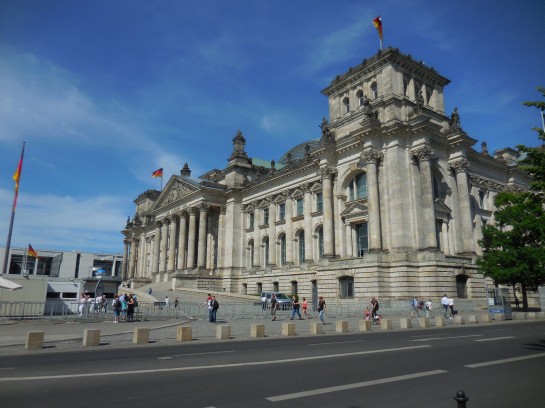
After some minutes of reflection, I went to the Reichstag entrance and presented my booking confirmation in front of a tent. I booked a tour of the glazed dome at least three weeks in advance. I had heard it was an architectural gem, and it was not possible to visit it without making a reservation. I was too early, so I decided to take a look at some monuments nearby, such as the Memorial to the Murdered Jews of Europe.

Memorial to Politicans who Opposed Hitler
First, I noticed a small monument of crooked slabs next to the entrance tent of the Reichstag. I had read that there were 96 slabs, symbolizing the 96 members of Parliament who had opposed Hitler and had paid the ultimate price for their bravery. The sharpness of the slabs made me think of the harsh times in which the politicians had lived and how it was a time when they had to pay with their lives to stand up for what they believed in. The monument had a harshness about it – the harshness of history, the harshness of their punishment. The slabs resembled gravestones.

Memorial to the Murdered Jews of Europe
Then I walked across from the American Embassy and found the 2,711 concrete pillars that made up the Memorial to the Murdered Jews of Europe. All the blocks were the same size, but their heights varied. It was possible to stand on the pillars or walk between them. I was very moved by this abstract memorial. Walking through the pillars, I felt claustrophobic and trapped, feelings I would associate with the plight of the Jews commemorated by this monument. The shadows around the pillars made me think of danger lurking around every corner, Jews not knowing who would give them up if they were in hiding, not knowing when they would be gassed in the concentration camps – for them, danger had lurked around every corner. I stood on one block and looked at the others. I thought they resembled caskets. In my opinion, this monument was ingenious. I would have never guessed that a memorial made up of concrete blocks could make such a strong impression on me.

In a park near the Reichstag, I walked through a rusty gate and noticed a small, tranquil circular pond. In the middle of the pond was a triangular stone with one flower on top. This was the Monument to the Murdered Sinti and Roma (commonly called gypsies) of Europe. On the pavement around the monument, the names of concentration camps had been inscribed. With my head down, I looked at the word Dachau on one paving stone and Auschwitz on another. Just seeing those names was poignant and powerful, heart wrenching even. It astonished me that something so simple as the names of the camps could move me so strongly. In fact, the entire monument moved me precisely because of its simplicity. The single flower on the stone slab symbolized reverence and respect for the lives lost, making me think that now the 500,000 Roma and Sinti who had died during World War II were no longer forgotten, no longer buried in history.


Monument to the Murdered Sinti and Roma of Europe
Then it was time to return to the Reichstag for my tour. First, I was ushered in a tent with many others and underwent a security check there. Then a large group crowded near the exit of the tent, waiting for the signal that we could walk up to the historical building.

Finally, we got the go ahead, and I stopped in front of the façade of the building, above which the words proclaimed “Dem Deutschen Volke” or “To the German People,” an ironic phrase considering the edifice’s turbulent history. The outer shape of the elegantly columned Reichstag had been preserved.
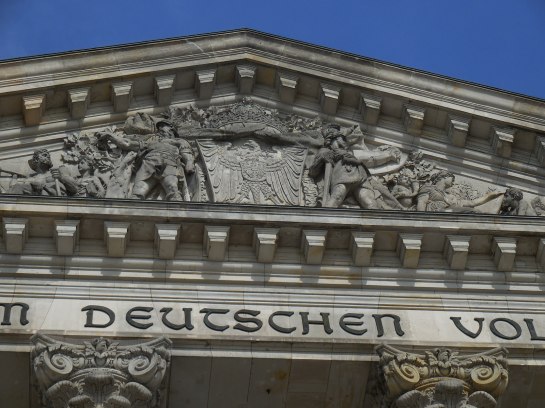
I thought back to the history of the building that was inaugurated in 1894. Back then, the Imperial Diet of the German Empire discussed and debated politics there. The Reichstag continued to serve this purpose until 1933. I tried to imagine standing in the crowd below as, during 1918, politician and head of the Social Democratic Party of Germany, Philipp Scheidemann, announced the formation of the German Republic from one of the Reichstag’s windows. When democracy came to an end in Germany and Hitler asserted more power in 1933, the Reichstag was set on fire and severely damaged. Who did the evil deed is still a mystery.

When the Russians set foot in Berlin during 1945, they placed a Soviet flag above the Reichstag. I could almost see the red flag with the hammer and sickle flapping in the breeze. The Berlin Wall, constructed in 1961, stood very near the Reichstag, which was situated in the West. During 1973, the Reichstag became home to a permanent exhibition on German history, and sometimes political meetings were held there.

During 1990, the reunification ceremony of Germany took place in the building by which I was so entranced. In 1995 British architect Norman Foster began reconstructing the building, leaving the exterior as a sort of outer shell in its old style while redoing the interior in a modern way. During 1999 the German Parliament made its home in the Reichstag after moving from Bonn.
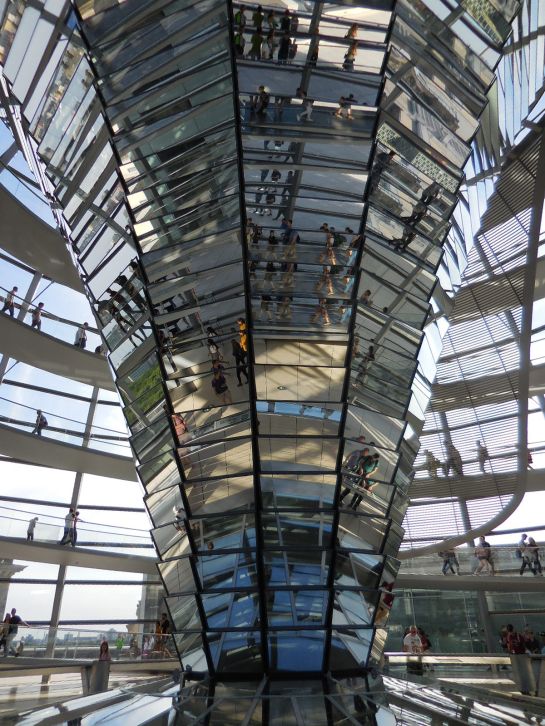
The moment I walked inside the Reichstag, I got a taste of the modern interior. It was a different world from the majestic exterior. The modern design was sleek, impressive. After taking an audio guide, I took an elevator and then made my way up the dome. For 20 minutes, I listened to interesting information about the Reichstag and the historic buildings that dotted the panorama as seen from the dome. I also learned about Berlin Cathedral and the three new parliamentary buildings surrounding the Reichstag, for instance. The modern cupola had replaced the original one that burned down in 1933. The modern architectural creation had a transparent quality that I found enlightening.

During this visit to Berlin, I felt as if the city was being transparent about its past, particularly about the horrors of World War II. The official names of the Holocaust Memorial and Monument to the Sinti and Roma have the word “murdered” in them, epitomizing harsh reality and a good, long look in the mirror of history, an acceptance of the past and a determination never to repeat it. With the right lighting, from the top of the dome there was a view of the plenary chamber. I felt as if nothing was hidden from the dome. Everything was there for everyone to see, judge and criticize as they pleased. There was a sense of fluidity and freedom in the architecture. During my visit in 1991, however, I had felt as if Berlin was trying to hide the horrific part of its past, which, of course, was impossible to do.
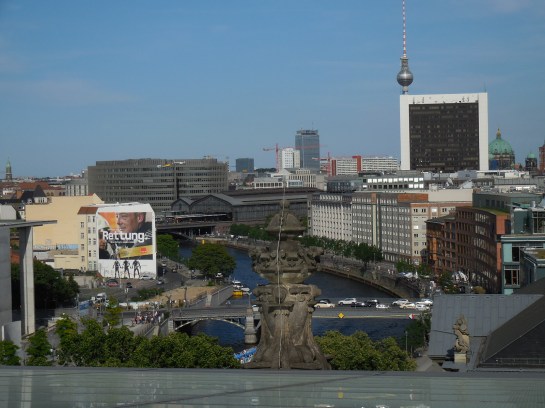
I also spent time taking photos from the extensive roof terrace, which also offered stunning views of the city. Unfortunately, I did not see the graffiti the Soviets left on the roof when they occupied the Reichstag at the end of World War II. The café on the terrace was closed during my visit.

I was very impressed with the preservation of the outer form of the building and the daring fresh look of the interior and dome. It was as if the Germans were not forgetting the past but were also moving forward.
Tracy A. Burns is a writer, proofreader and editor in Prague.
